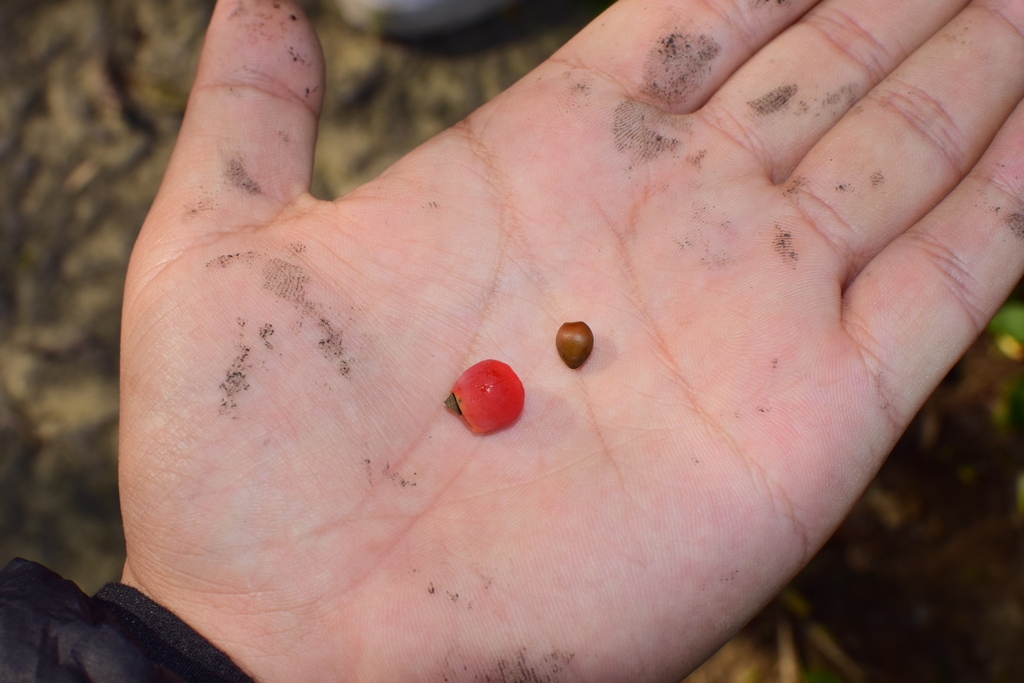Taxus chinensis
Common Name(s):
- Phonetic Spelling
- TAKS-us chi-NEN-sis
- This plant has high severity poison characteristics.
- See below
- Description
-
The Chinese yew is a woody, needled evergreen tree or shrub in the Taxaceae family. It is native to China and the word chinensis refers to China. The species was found by Augustine Henry, a Scotsman, in China around 1885 to 1886.
It can be grown in full sun or partial shade and requires sandy or loamy, neutral to acidic soil with good drainage. It can rapidly reach its mature height of 10 feet and width of 10 to 15 feet wide. It is easy to propagate from stem cuttings, responds well to pruning, and is tolerant of heat and drought.
As with all Taxus species, the fleshy structure partially surrounding the seed is the aril. A fleshy aril about the size of a pea is open on one end to reveal a single, hard seed. The aril is a food source for wildlife, particularly songbirds. It has exfoliating bark.
Chinese yew is primarily grown for its foliage. Employ it in the landscape as a barrier or privacy screen, or an accent in a winter garden. A specimen just outside the lath house at the JC Raulston Arboretum at North Carolina State University is still performing magnificently after many years.
Insects, Diseases, and Other Plant Problems: Leaf blight and fungal diseases can be an issue. It is a host plant for the walnut root lesion nematode.
VIDEO Created by Elizabeth Meyer for "Trees, Shrubs and Conifers" a plant identification course offered in partnership with Longwood Gardens.
- Profile Video:
- See this plant in the following landscape:
- Cultivars / Varieties:
-
- Tags:













- Cultivars / Varieties:
-
- Tags:
-
-
Attributes:
- Genus:
- Taxus
- Species:
- chinensis
- Family:
- Taxaceae
- Life Cycle:
- Woody
- Recommended Propagation Strategy:
- Stem Cutting
- Country Or Region Of Origin:
- China
- Wildlife Value:
- Birds eat the red aril that surrounds the seed.
- Play Value:
- Buffer
- Easy to Grow
- Textural
- Wildlife Food Source
- Edibility:
- Red arils in small amounts are edible, seeds, bark, leaves are poisonous.
- Dimensions:
- Height: 10 ft. 0 in. - 10 ft. 0 in.
- Width: 10 ft. 0 in. - 15 ft. 0 in.
-
-
Whole Plant Traits:
- Plant Type:
- Poisonous
- Shrub
- Tree
- Woody Plant Leaf Characteristics:
- Needled Evergreen
- Habit/Form:
- Ascending
- Pyramidal
- Rounded
- Growth Rate:
- Rapid
- Maintenance:
- Low
- Texture:
- Fine
-
-
Cultural Conditions:
- Light:
- Full sun (6 or more hours of direct sunlight a day)
- Partial Shade (Direct sunlight only part of the day, 2-6 hours)
- Soil Texture:
- Loam (Silt)
- Sand
- Soil pH:
- Acid (<6.0)
- Neutral (6.0-8.0)
- Soil Drainage:
- Good Drainage
- Available Space To Plant:
- 12-24 feet
- NC Region:
- Coastal
- Piedmont
- USDA Plant Hardiness Zone:
- 5b, 6a, 6b, 7a, 7b
-
-
Fruit:
- Fruit Color:
- Red/Burgundy
- Fruit Value To Gardener:
- Showy
- Display/Harvest Time:
- Fall
- Fruit Length:
- < 1 inch
- Fruit Width:
- < 1 inch
- Fruit Description:
- The female cone is a fleshy, red, cup-like structure in which is borne a single seed.
-
-
Leaves:
- Woody Plant Leaf Characteristics:
- Needled Evergreen
- Leaf Color:
- Brown/Copper
- Gold/Yellow
- Green
- Leaf Feel:
- Leathery
- Leaf Value To Gardener:
- Showy
- Leaf Type:
- Needles
- Leaf Arrangement:
- Alternate
- Leaf Shape:
- Lanceolate
- Hairs Present:
- No
- Leaf Length:
- < 1 inch
- Leaf Width:
- < 1 inch
- Leaf Description:
- The convex needles are flat, range in color from dark green, yellow-green to bronze.
-
-
Bark:
- Bark Color:
- Dark Brown
- Dark Gray
- Red/Burgundy
- Surface/Attachment:
- Exfoliating
- Bark Description:
- The bark is thin and exfoliates in strips or flakes. The color ranges from reddish to purple brown to gray.
-
-
Stem:
- Stem Is Aromatic:
- No
- Stem Cross Section:
- Round
- Stem Description:
- The thin stems are grooved along the leaf bases.
-
-
Landscape:
- Landscape Location:
- Patio
- Walkways
- Landscape Theme:
- Asian Garden
- Winter Garden
- Design Feature:
- Accent
- Barrier
- Screen/Privacy
- Specimen
- Attracts:
- Songbirds
- Problems:
- Poisonous to Humans
- Problem for Cats
- Problem for Dogs
- Problem for Horses
-
-
Poisonous to Humans:
- Poison Severity:
- High
- Poison Symptoms:
- Nervousness, trembling, slow pulse, pupil dilation, difficult breathing, seizures (dogs), abdominal pain, vomiting, diarrhea, weakness, convulsions; may be fatal Early signs: muscular tremors, dyspnea, seizures in dogs.
- Poison Toxic Principle:
- Alkaloid taxine
- Causes Contact Dermatitis:
- No
- Poison Part:
- Bark
- Leaves
- Seeds








